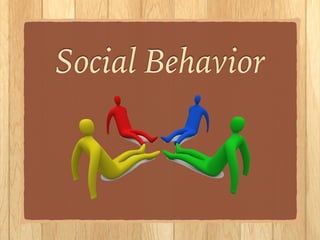
Social Influences on Behavior
- 2. Social Influence The process by which the actions of an individual or group affect the behavior of others. Group: Two or more people who interact with one another, perceive themselves as part of a group, and are interdependent.
- 3. Norms Groups develop “norms”: expectations regarding what behavior is appropriate within the group, and what behavior is not. AmishKids Punk-rockKids
- 4. Norms Groups develop “norms”: expectations regarding what behavior is appropriate within the group, and what behavior is not. BaptistPreacher KKKMembers
- 5. Norms Groups develop “norms”: expectations regarding what behavior is appropriate within the group, and what behavior is not. MariachiBand ElvisImpersonators
- 6. Norms Groups develop “norms”: expectations regarding what behavior is appropriate within the group, and what behavior is not. Prisoners Cheerleaders
- 7. Worksheet #1 Answer question in box #1. In general, what happens when someone does not follow the norms of a group they are in? ? ? ? ?
- 8. Worksheet #2 On your worksheet, make a list of groups that you belong to. (Yes, we all belong to many groups that each have different behavioral norms!) Georgi family Friends from middle/ high school Friends from college KIS Faculty Period 8 Psych Period 3 Psych Period 1 English Me + Sister
- 9. Types of Social Pressure Conformity A change in behavior or attitudes brought about by a desire to follow the beliefs or standards of other people. Compliance A type of social influence where an individual does what someone else wants them to do, following his or her request or suggestion. Obedience A change in behavior in response to the commands of others.
- 10. Conformity A change in behavior or attitudes brought about by a desire to follow the beliefs or standards of other people. If we do not conform to the behavior of the groups we are in, we may face rejection, exclusion, or loss of reputation. What if your friends are having a costume party, but you decide to go without wearing one? In school, you are expected to dress and behave in certain ways.What happens when you don’t?
- 11. Video 1
- 12. Conformity Facts about conformity: • The more attractive a group appears to its members, the greater its ability to produce conformity. • The lower a person’s rank or status is within a group, the easier it is for the group to modify that person’s behavior. • Conformity is more likely in public situations. • Fact vs. Opinion: it is easier to create conformity when asked to give an opinion on something. • Groups that are unanimous create the greatest conformity pressures.
- 13. Compliance Behavior that occurs in response to direct social pressure. A type of social influence where an individual does what someone else wants them to do, following his or her request or suggestion. • Foot-in-the-Door Technique • Door-in-the-Face Technique • “That’s Not All” Technique • Not-so-free Sample Technique • Low-Ball Technique • Bait-and-Switch Technique “door in the face” (Worksheet #3)
- 14. Obedience A change in behavior in response to the commands of others (following orders). Obedience usually only occurs in special relationships with authority figures (such as a parent, teacher, or boss).
- 15. Worksheet #4 We don’t follow the suggestions or orders of all people equally. 1. What characteristics can you find in the people/groups that we are most willing to change our behavior for?
- 16. The Milgram Shock Experiment In 1963, Yale Psychologist Stanley Milgram created an experiment to see if participants would follow orders even when the requested behavior went against their moral beliefs or good judgment. Fake Test Subject Participant Experimenter (Administers shocks) (Pretends to feel pain) (Urges the participant to keep going) A researcher asks the participant to administer electric shocks to a test subject when he answers questions incorrectly.The test subject is an actor, who makes noises of pain when he receives the shocks.The participant is made to believe that each shock is stronger than the last one.
- 17. The Milgram Shock Experiment RESULTS: All of Milgram’s original participants continued the experiment to 300 volts of electricity. 65% of them administered the maximum voltage of 450, which was clearly labeled as life-threatening. Milgram concluded that ordinary people are likely to follow orders given by an authority figure, even to the extent of killing an innocent human being.
- 18. The Milgram Shock Experiment The participants claimed that they administered the shocks for three main reasons: 1. The authority figure seemed trustworthy 2. The cause was good (scientific research) 3. They believed that if anything bad happened, the researcher would take full responsibility.